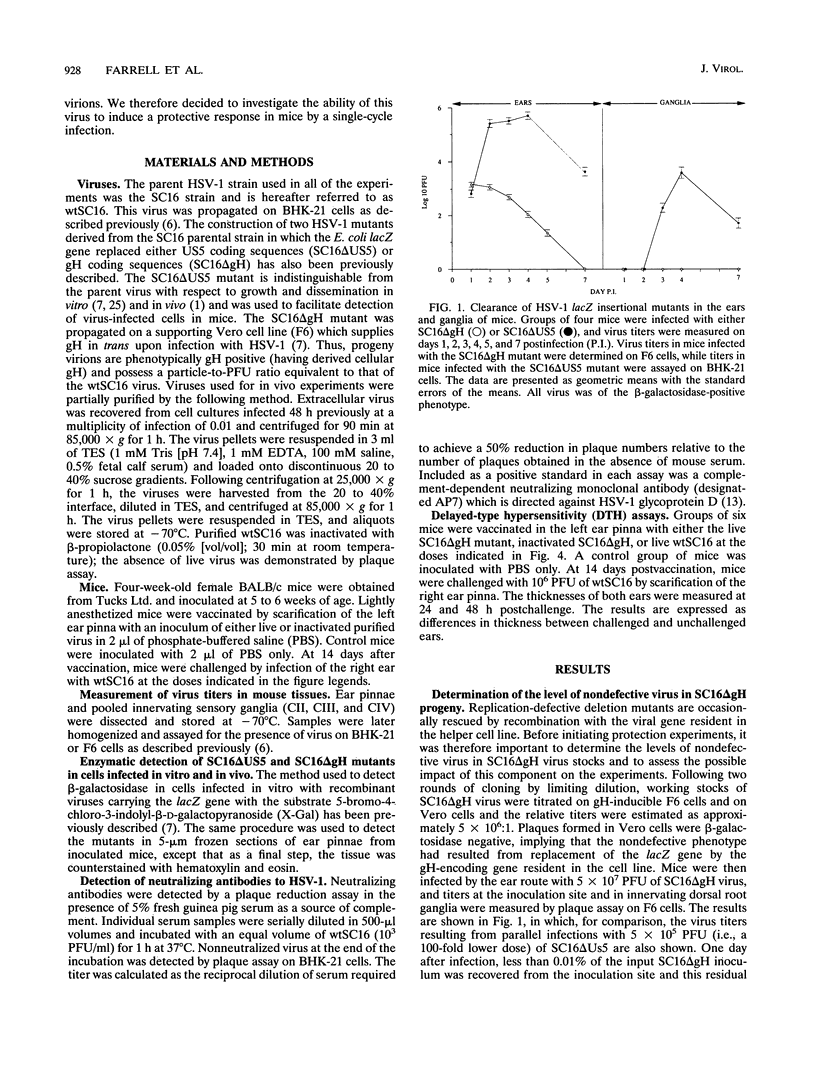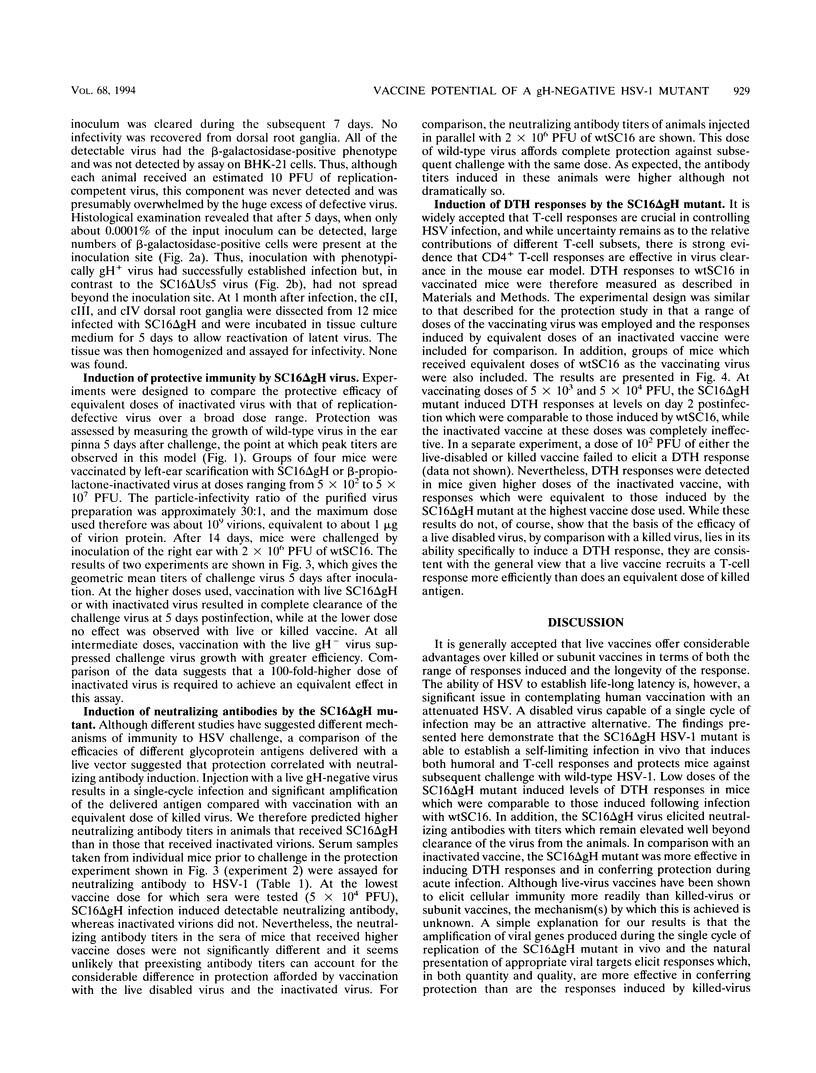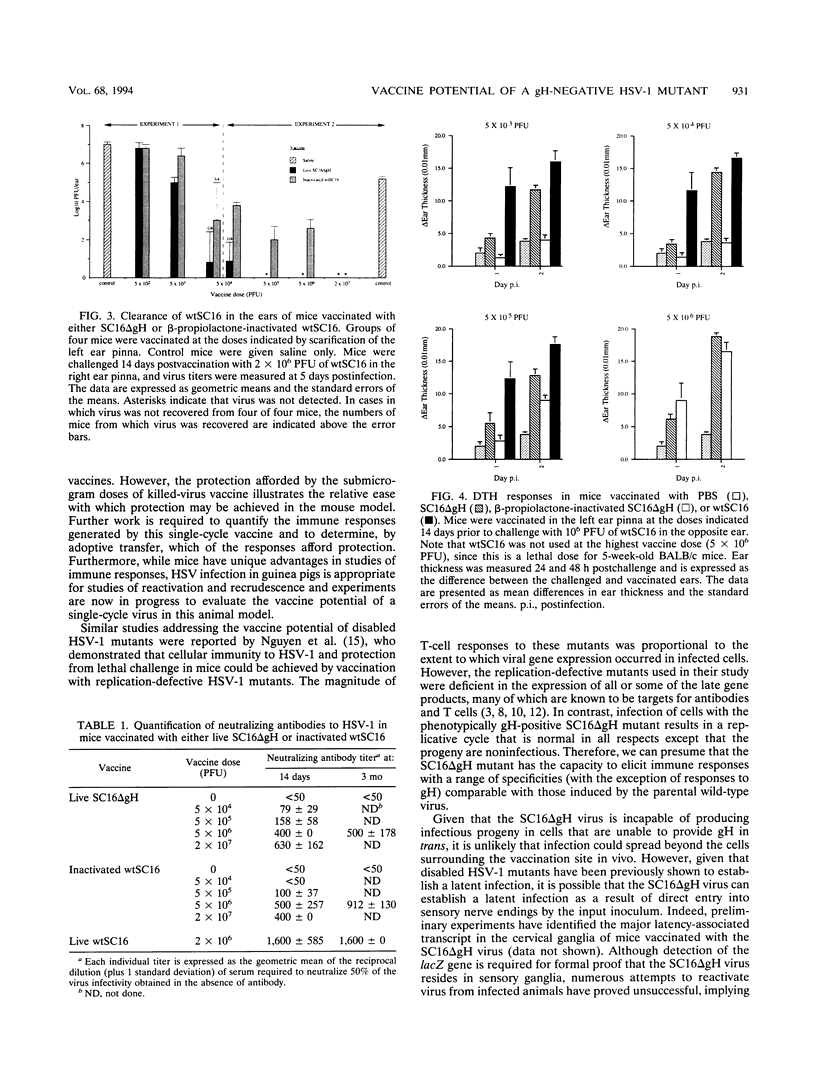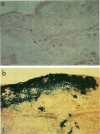Abstract
Several approaches to the production of vaccines to human herpesviruses have been proposed. Subunit vaccines, subunits delivered by live vectors, and rationally attenuated vaccines have all been shown to be efficacious in animal models but suffer from uncertainties as to the roles of individual genes involved in pathogenesis and the most relevant components of the immune response required for protection in humans and the target antigens involved. With these problems in mind, we examined the vaccine potential of a fully disabled herpes simplex virus type 1 mutant that is capable of only a single round of replication, since a virus of this type should induce the full spectrum of immune responses but has no pathogenic potential. A virus has been described which lacks essential glycoprotein H (gH) and can be propagated in a cell line which supplies gH in trans (A. Forrester, H. Farrell, G. Wilkinson, J. Kaye, N. Davis-Poynter, and T. Minson, J. Virol. 66:341-348, 1992). Infection of normal cells with this mutant is indistinguishable from a wild-type infection, except that the resulting progeny are gH negative and noninfectious: the virus is self-limiting. Infection of mice by the ear pinna route was similarly self-limiting in that input infectivity decreased rapidly at the inoculation site and no infectivity was detected in sensory ganglia. Animals given a wide range of doses of the gH-negative mutant produced both humoral and T-cell responses to herpes simplex virus type 1 and proved solidly resistant to challenge with a high dose of wild-type virus. The gH-negative mutant is presumably capable of establishing a latent infection, but since no infectious virus was detected in numerous attempts to reactivate the mutant, the risk of a pathogenic outcome is minimal.
Full text
PDF





Images in this article
Selected References
These references are in PubMed. This may not be the complete list of references from this article.
- Blacklaws B. A., Nash A. A. Immunological memory to herpes simplex virus type 1 glycoproteins B and D in mice. J Gen Virol. 1990 Apr;71(Pt 4):863–871. doi: 10.1099/0022-1317-71-4-863. [DOI] [PubMed] [Google Scholar]
- Burke R. L. Contemporary approaches to vaccination against herpes simplex virus. Curr Top Microbiol Immunol. 1992;179:137–158. doi: 10.1007/978-3-642-77247-4_9. [DOI] [PubMed] [Google Scholar]
- Efstathiou S., Kemp S., Darby G., Minson A. C. The role of herpes simplex virus type 1 thymidine kinase in pathogenesis. J Gen Virol. 1989 Apr;70(Pt 4):869–879. doi: 10.1099/0022-1317-70-4-869. [DOI] [PubMed] [Google Scholar]
- Forrester A., Farrell H., Wilkinson G., Kaye J., Davis-Poynter N., Minson T. Construction and properties of a mutant of herpes simplex virus type 1 with glycoprotein H coding sequences deleted. J Virol. 1992 Jan;66(1):341–348. doi: 10.1128/jvi.66.1.341-348.1992. [DOI] [PMC free article] [PubMed] [Google Scholar]
- Johnson R. M., Lancki D. W., Fitch F. W., Spear P. G. Herpes simplex virus glycoprotein D is recognized as antigen by CD4+ and CD8+ T lymphocytes from infected mice. Characterization of T cell clones. J Immunol. 1990 Jul 15;145(2):702–710. [PubMed] [Google Scholar]
- Kapoor A. K., Nash A. A., Wildy P. Pathogenesis of herpes simplex virus in B cell-suppressed mice: the relative roles of cell-mediated and humoral immunity. J Gen Virol. 1982 Jul;61(Pt 50):127–131. doi: 10.1099/0022-1317-61-1-127. [DOI] [PubMed] [Google Scholar]
- Martin S., Cantin E., Rouse B. T. Evaluation of antiviral immunity using vaccinia virus recombinants expressing cloned genes for herpes simplex virus type 1 glycoproteins. J Gen Virol. 1989 Jun;70(Pt 6):1359–1370. doi: 10.1099/0022-1317-70-6-1359. [DOI] [PubMed] [Google Scholar]
- McDermott M. R., Graham F. L., Hanke T., Johnson D. C. Protection of mice against lethal challenge with herpes simplex virus by vaccination with an adenovirus vector expressing HSV glycoprotein B. Virology. 1989 Mar;169(1):244–247. doi: 10.1016/0042-6822(89)90064-0. [DOI] [PubMed] [Google Scholar]
- McLaughlin-Taylor E., Willey D. E., Cantin E. M., Eberle R., Moss B., Openshaw H. A recombinant vaccinia virus expressing herpes simplex virus type 1 glycoprotein B induces cytotoxic T lymphocytes in mice. J Gen Virol. 1988 Jul;69(Pt 7):1731–1734. doi: 10.1099/0022-1317-69-7-1731. [DOI] [PubMed] [Google Scholar]
- Minson A. C., Hodgman T. C., Digard P., Hancock D. C., Bell S. E., Buckmaster E. A. An analysis of the biological properties of monoclonal antibodies against glycoprotein D of herpes simplex virus and identification of amino acid substitutions that confer resistance to neutralization. J Gen Virol. 1986 Jun;67(Pt 6):1001–1013. doi: 10.1099/0022-1317-67-6-1001. [DOI] [PubMed] [Google Scholar]
- Nguyen L. H., Knipe D. M., Finberg R. W. Replication-defective mutants of herpes simplex virus (HSV) induce cellular immunity and protect against lethal HSV infection. J Virol. 1992 Dec;66(12):7067–7072. doi: 10.1128/jvi.66.12.7067-7072.1992. [DOI] [PMC free article] [PubMed] [Google Scholar]
- Nishiyama Y., Yamada Y., Kurachi R., Daikoku T. Construction of a US3 lacZ insertion mutant of herpes simplex virus type 2 and characterization of its phenotype in vitro and in vivo. Virology. 1992 Sep;190(1):256–268. doi: 10.1016/0042-6822(92)91212-d. [DOI] [PubMed] [Google Scholar]
- Okazaki W., Purchase H. G., Burmester B. R. Protection against Marek's disease by vaccination with a herpesvirus of turkeys. Avian Dis. 1970 May;14(2):413–429. [PubMed] [Google Scholar]
- Openshaw H., Asher L. V., Wohlenberg C., Sekizawa T., Notkins A. L. Acute and latent infection of sensory ganglia with herpes simplex virus: immune control and virus reactivation. J Gen Virol. 1979 Jul;44(1):205–215. doi: 10.1099/0022-1317-44-1-205. [DOI] [PubMed] [Google Scholar]
- Rooney J. F., Wohlenberg C., Cremer K. J., Moss B., Notkins A. L. Immunization with a vaccinia virus recombinant expressing herpes simplex virus type 1 glycoprotein D: long-term protection and effect of revaccination. J Virol. 1988 May;62(5):1530–1534. doi: 10.1128/jvi.62.5.1530-1534.1988. [DOI] [PMC free article] [PubMed] [Google Scholar]
- Schmid D. S., Rouse B. T. The role of T cell immunity in control of herpes simplex virus. Curr Top Microbiol Immunol. 1992;179:57–74. doi: 10.1007/978-3-642-77247-4_4. [DOI] [PubMed] [Google Scholar]
- Simmons A., Nash A. A. Role of antibody in primary and recurrent herpes simplex virus infection. J Virol. 1985 Mar;53(3):944–948. doi: 10.1128/jvi.53.3.944-948.1985. [DOI] [PMC free article] [PubMed] [Google Scholar]
- Stanberry L. R., Bernstein D. I., Burke R. L., Pachl C., Myers M. G. Vaccination with recombinant herpes simplex virus glycoproteins: protection against initial and recurrent genital herpes. J Infect Dis. 1987 May;155(5):914–920. doi: 10.1093/infdis/155.5.914. [DOI] [PubMed] [Google Scholar]
- Sunstrum J. C., Chrisp C. E., Levine M., Glorioso J. C. Pathogenicity of glycoprotein C negative mutants of herpes simplex virus type 1 for the mouse central nervous system. Virus Res. 1988 Aug;11(1):17–32. doi: 10.1016/0168-1702(88)90064-0. [DOI] [PMC free article] [PubMed] [Google Scholar]
- Weber P. C., Levine M., Glorioso J. C. Rapid identification of nonessential genes of herpes simplex virus type 1 by Tn5 mutagenesis. Science. 1987 May 1;236(4801):576–579. doi: 10.1126/science.3033824. [DOI] [PubMed] [Google Scholar]
- de Leeuw P. W., van Oirschot J. T. Vaccines against Aujeszky's disease: evaluation of their efficacy under standardized laboratory conditions. Vet Q. 1985 Jul;7(3):191–197. doi: 10.1080/01652176.1985.9693982. [DOI] [PubMed] [Google Scholar]



